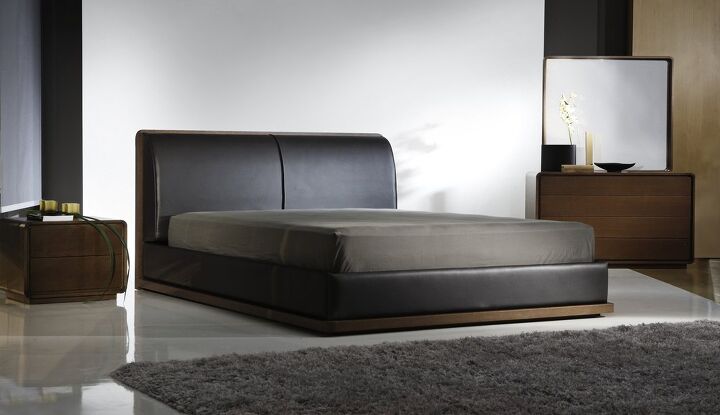The Difference Between A Low Profile Bed And Platform Bed

Getting a good night’s rest is essential if you want to be as productive and healthy as possible. A significant determining factor in how you sleep is your bed, so choosing one that works for you is essential. Two popular bed terms are low profile beds and platform beds, but what is the difference between them?
The main difference between a low profile bed and a platform bed is a platform bed doesn’t use a box spring. A low profile bed frame uses a box spring, but some platform beds are also low profile beds. A low profile bed sits closer to the ground than a traditional bed, making it ideal for rooms with limited ceiling height.
Choosing which bed is best for you depends on your available space, style preference, and storage needs. If you’re trying to decide between a platform bed and low profile bed frame, it’s wise to familiarize yourself with the similarities and differences.
What’s the Difference Between a Low Profile Bed and a Platform Bed?
People often use the terms platform bed and low profile bed interchangeably. Usually, this is since both beds tend to sit lower to the ground than traditional beds. And low profile beds and platform beds share several similarities.
However, they aren’t exactly the same. The easiest way to think about it is a platform bed is one type of low profile bed. But you can also have a platform bed that is as tall as a standard bed.
Alternatively, you can have a bed frame that sits close to the ground and holds a box spring and mattress. This setup is a low profile bed but not a platform bed.
The Biggest Difference Between a Low Profile Bed and a Platform Bed Is the Box Spring
The main distinction between a low profile bed and, more specifically, a platform bed is the box spring. A low profile bed has a box spring if it is a low profile bed frame. In this case, the box spring provides the primary support for the mattress.
However, a platform bed does not use a box spring. As the name implies, the mattress rests directly on a platform, which can be a solid base or a set of slats.
The box spring for a low profile bed is typically not as thick as a traditional box spring. Standard box springs are typically 9 inches or more. In comparison, a low profile box spring is between 4 and 6 inches thick.
This thinner box spring doesn’t add as much support as its thicker counterpart, but it maintains the low profile look.
Size
Platform beds and low profile beds come in the same standard sizes as typical beds. You can find both styles in twin, twin XL, full, queen, king, California king, and so on.
The length and width of the overall bed depend on the mattress size and the bed style. Therefore, these dimensions can vary from bed to bed and would not be much different from a standard bed.
Both beds can low to the ground, but you can also opt for a taller platform bed. A standard bed with a mattress is about 25 inches tall. A low profile bed frame is usually about 7 ½ inches tall.
The average mattress is anywhere from 8 to 14 inches thick. Mattresses for low profile beds are usually thinner to maintain the bed’s low height. Therefore, a low profile bed with a box spring and a mattress would be roughly 20 to 22 inches tall.
A Platform Bed Can Be as Tall as a Standard Bed
A platform bed doesn’t use a box spring, so the overall height depends on the bed itself and the mattress. For example, a 10-inch platform with an 8-inch mattress gives you an overall height of 18 inches. This arrangement would give you a low profile bed.
But a 15-inch platform with a 10-inch mattress gives you the standard bed height of 25 inches. Usually, the biggest reason for a taller platform is that it contains more storage.
Storage Features
Platform beds often feature some type of storage in the bed base, like drawers or tilt-outs. For a low profile platform bed, you can expect shallow drawers and a base height of roughly 10 inches.
However, there are high-rise platform beds with double-stacked drawers that are much taller. These taller styles can be 20 to 22 inches from the floor to the bottom of the mattress.
This taller base results in an overall height from floor to mattress top closer to 28 to 32 inches. This height makes this style of platform bed taller than a standard bed.
If you opt for a low profile bed that uses a box spring and bed frame, you typically won’t find included storage. Additionally, since it’s so low to the ground, you will have limited under-the-bed storage as well.
Design
Low profile beds and platform beds come in a wide range of styles, making it easy to match your bedroom’s design. Platform beds can be minimalistic, with clean lines, or ornate and bulky, depending on the size and height you choose. For example, a high-rise platform bed can tend to overpower a smaller space.
Low profile beds usually have a cleaner look with straight lines and minimal frills to help maintain the desired sleek look. Often, if you’re choosing a low profile bed, it’s because you’re working with a smaller space and don’t want the room to feel cramped. This reasoning stands for low profile platform beds too.
Support
A platform bed that uses a solid base provides excellent support. If your platform bed uses individual slats, they won’t offer as much support as a solid base, but it’s still adequate. You can increase the support by adding extra slats and placing them closer together.
Box springs usually provide a little more give, which might not be a good fit for certain sleepers. When it comes down to the overall support, you also need to consider your mattress.
You can get good support from platform beds and low profile beds that use a box spring. However, it comes down to the individual bed and mattress you choose.
Cost
You spend a lot of time in your bed, so you want to get something that will last and is comfortable. Therefore, it’s not that surprising that beds can be expensive. For platform beds and low profile beds, prices can vary dramatically depending on the style and manufacturer.
Typically, you might assume you’ll save money when you buy a platform bed since you don’t need to purchase a box spring. However, you could fall in love with a $1,000 upholstered platform bed with drawer storage.
In this example, you’ll spend a lot more than if you bought a simple metal bed frame that costs $165. (Even considering the additional cost of a low profile box spring for about $150 to $200.)
Summary
Finding the right bed is an important component of getting the good night’s sleep you need. If you’re working in a small space, you might prefer a low profile bed. These beds typically are 18 to 22 inches tall with the mattress.
Low profile beds often provide a sleek, contemporary feel to a space, and if you use a frame, you’ll need a box spring to support your mattress. However, a platform bed doesn’t require a box spring since the mattress sits directly on the base or slats.
A platform bed can also be a low profile bed. However, you can also have a high rise platform bed as tall if not taller than a standard bed.
Platform beds also usually feature some type of storage depending on the overall height of the base. Both platform and low profile beds can come in many styles and price points.
The biggest difference between the two is that a platform bed doesn’t need a box spring. However, a low profile bed could also be a platform bed or it could be a bed frame and box spring.

Stacy Randall is a wife, mother, and freelance writer from NOLA that has always had a love for DIY projects, home organization, and making spaces beautiful. Together with her husband, she has been spending the last several years lovingly renovating her grandparent's former home, making it their own and learning a lot about life along the way.
More by Stacy Randall












![10 Best Electric Pressure Washers – [2022 Reviews & Guide]](https://cdn-fastly.upgradedhome.com/media/2023/07/31/9070600/10-best-electric-pressure-washers-2022-reviews-guide.jpg?size=350x220)








![12 Washing Machine Brands to Avoid [with Recall Data]](https://cdn-fastly.upgradedhome.com/media/2023/07/31/9075781/12-washing-machine-brands-to-avoid-with-recall-data.jpg?size=350x220)





